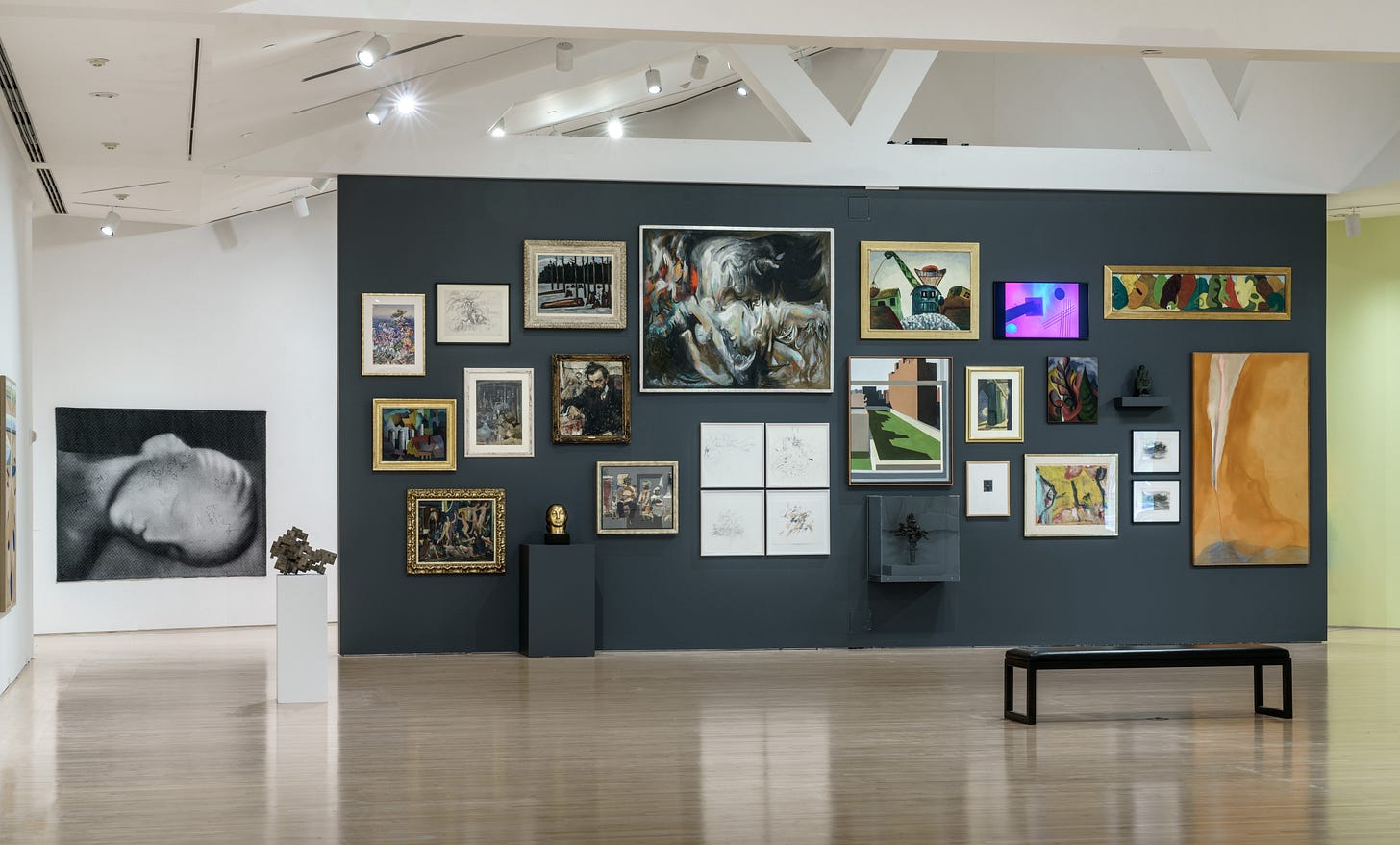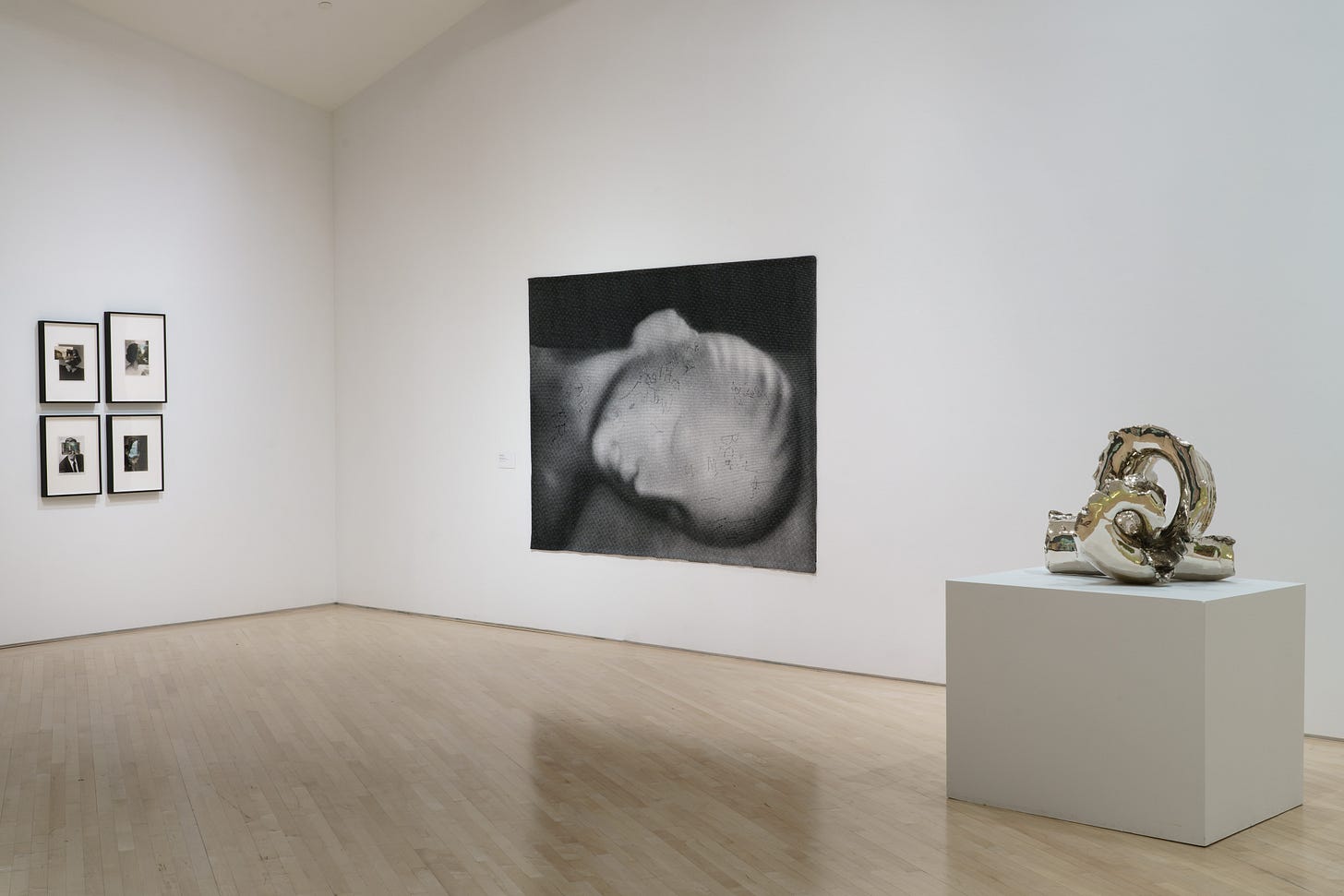A Mystical Survey at The Kemper Museum
"Infinite Regress" came with an ambitious title. Does the exhibition stands up to its statement?

In a world where the reality can feel overwhelming and often cruel, perhaps we could all use the tender touch of dream and spirituality. On view at Kemper Museum of Contemporary Art in Kansas City, Infinite Regress: Mystical Abstraction from the Permanent Collection and Beyond is clearly designed to sweep the viewer away from the tangible, physical world for a brief moment.
“Infinite Regress brings the past in dialogue with the present through selections from the Permanent Collection paired with works by contemporary artists exhibiting at the museum for the first time on the occasion of its 30th anniversary. The exhibition connects these works through a shared vocabulary of mystical abstraction that has both historical and contemporary resonance, engaging periods of extreme transformation in nature and technology.”
– Kemper Museum of Contemporary Art.
An ambitious survey by nature, the exhibition shows work from the museum’s permanent collection alongside contemporary artists giving what might be one of the most profound and diverse painting genres new edges. The pieces on display vary from traditional paintings to sculptures, drawings, photography, textile, video, and assemblage. Most of the work lined up neatly around the gallery with a salon wall sitting in the center as a separator, ensuring a linear viewing experience where one would either go clockwise or counterclockwise through the gallery and return to the salon display in the end.

Personally, I appreciated curator Kevin Moore’s decision to spruce up the stereotypical mystical abstract motifs such as the distorted dreamscape, arrangement of geometrical shapes, and botanical fairytales by including pieces embracing the mysticism with a contemporary touch, with a considerable portion of work from living artists. For example, Defaced Muse, Canadian artist Shannon Bool’s 2018 jacquard tapestry with embroidery emphasizes the above-shoulder portion of a faceless female figure. Shrouded in shades of tender greys, the figure looks simultaneously artificial and organic. At its large scale, the monochromatic tapestry almost looks like a bitmap print, diffusing the figure into countless and distinguishable weaves and stitches, deconstructing our perception of solidity and physical existence.
Moore also did a good job by including artists who leverage mystical abstraction to investigate contemporary humanitarian and societal rhetoric, breaking the stereotype that the genre tends to be gentle, feminine, and spiritual but detached from the unpleasantries happening in the real world. For example, in Koak’s mixed media painting California Landscape #3, the devastating wildfire ingulfs the sky. The destruction was captured in a poetic way with dancing tree branches and wavy lines and that gentleness amplifies the distress and urgency of environmental crises.
Another powerful piece was Iranian artist Amir H. Fallah’s acrylic painting. Titled “Between All the Words, My Voice is But a Whisper, a Hum,” the painting pairs the original and the mirrored image of a woman kneeling on the ground, with one hand pressing on her chest and the other extending outward, as if inviting the audience to approach and listen. Yet the woman is wrapped in a patterned blanket. Her voice is muffled. Her face and identity removed.

However, when we look at a survey exhibition including this many different types of artwork, we must ask ourselves these questions: what is this exhibition’s purpose? Do the pieces in the show accurately summarize the history and ongoing development of the subject? Does the exhibition, in its entirety, sustain an informative and convincing narrative?
As much as I’d enjoyed looking at these individual pieces, I’m afraid the exhibition falls short in its collective power mainly due to two reasons.
One, the artwork felt scrambled. While a survey exhibition doesn’t necessarily have a well developed narrative like a curatorial project designed to explore a specific theme or carry a certain message, logic and sequence is still desirable as they help guide the visiting experience and thus make the exhibition more accessible to audiences with different levels of art history knowledge and art appreciation abilities, as well as more engaging to audiences who may be from a younger age group or, simply, stepped into the museum on a fluke.
There are many effective ways to create a stronger flow in a gallery as spacious as Kemper’s. For example, additional vinyl texts segmenting the pieces on display by categories, chronological orders, or shared themes. A lack of artwork labels also largely left the piece inanimate and distant when mystical abstraction was meant to be intimate, tender, and very often, sentimental. While I never believe it’s a museum’s job to tell the audience what to think or what a piece is concretely about, as educational institutions, it would have been beneficial to provide some sort of guidance.
This lack of structure is best shown by the salon wall. As much as I personally always loved salon-style display and have adopted the format for my own work and past curatorial projects, we also must be aware that when a salon wall goes all the way up to the ceiling, it is inevitable that the individuality of the artworks on display become diluted unless the curator knows how to help the audience refocus their gaze. Why are these pieces placed on the center salon wall? What is their shared significance in mystic abstraction’s art history? What is the curator hoping to accomplish with display, other than creating a visually interesting collage of artwork? Without supportive information, these pieces become suspended and cluttered, and the top row naturally becomes difficult for anyone at ground level to view clearly and appreciate the details.
A similar salon design is also used in Kemper’s cafe area but works just fine because in that case, the design mattered more than the imageries climbing all the way up to the ceilings. The aesthetic was perfect and the ambiance of an art museum cafe cannot have been captured better. However, in an actual exhibition, especially a survey-style exhibition, the salon wall might have been off the mark. If the audience can’t even observe the pieces, how can they survey the artist’s practice and interpretation of the genre’s universal themes?

And the exhibition felt thin. So thin that a chill hovered between the gallery’s pale walls, further enlarging the physical and figurative gaps preventing the pieces to converse with each other and the exhibition to converse with the audience.
Because Kemper has a beautiful gallery space — beautiful and massive.
At 5,697 square feet, Charlotte Crosby Kemper Gallery would’ve been the perfect space for a deep dive into the immersive mystical abstraction world. Large scale sculptures, site specific installations, even mid-air suspension… the possibilities are boundless whereas the chances for a curator to have this spacious and tolerating a site to work with are scarce in the art world. The floor could’ve been a field that sprouted imagination and transcendence. The white walls could served as blank canvases to complement the pieces on display.
Ironically, even the additional reading materials the museum so thoughtfully curated and placed outside of the gallery entrance talked about artists working in nontraditional formats and medium, creating time-sensitive, stie-specific installations and bricolages that perfectly capture mystical abstraction’s essences while exploring new possibilities carried by strong advocacy and a deep passion for the humanity.
Yet the actual exhibition was like a page torn out of a gen-ed art history textbook. You walk into the space expecting something so much more, and you come out with a sigh. The show was decent. The art was good.
I guess it could be a fun date idea for art-loving couples.

Infinite Regress: Mystical Abstraction from the Permanent Collection and Beyond is on view at The Kemper Museum of Contemporary Art through February 23rd, 2025 in the main gallery space.






Thank you for your review of the show. i hope that the rest of the city follow-ups your lead.
Personally i felt similar to your observations of the show. I’d add that it was the anniversary show, marking its 30 years in the city, yet none of that work has a tie to KC. It might as well been a show in any other city. 🕳️